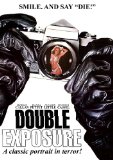| Reviews & Columns |
|
Reviews DVD TV on DVD Blu-ray 4K UHD International DVDs In Theaters Reviews by Studio Video Games Features Collector Series DVDs Easter Egg Database Interviews DVD Talk Radio Feature Articles Columns Anime Talk DVD Savant Horror DVDs The M.O.D. Squad Art House HD Talk Silent DVD
|
DVD Talk Forum |
|
|
| Resources |
|
DVD Price Search Customer Service #'s RCE Info Links |
|
Columns
|
|
|
Double Exposure (1983)
Fairly impressive low-budget psychological thriller. Scorpion Releasing, which is fast making a name for itself putting out these hard-to-find vintage shockers, has released Double Exposure, the lurid 1982 slasher flick from Crown International Pictures starring Michael Callan, Joanna Pettet, James Stacy, Cleavon Little, Pamela Hensley, Seymour Cassel, Robert Tessier, and Sally Kirkland. Initially begun as an updated expansion of Callan's and director William Byron Hillman's earlier psycho-thriller from 1974, The Photographer, Double Exposure was then overhauled into its own suspenser, with surprisingly effective results. Some choice bonuses, including two commentary tracks, are extras on this Katarina's Nightmare Theater presentation (which features Double Exposure remastered in its original scope presentation for the first time on home video).
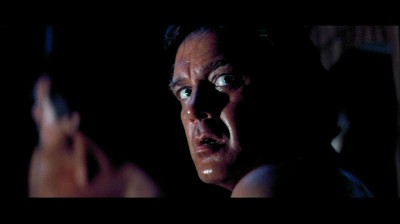
Freelance photographer Adrian Wilde (Michael Callan) is having trouble sleeping at night...because he keeps dreaming he's murdering his models in sickeningly violent fashion. Talks with his shrink Dr. Frank Curtis (Seymour Cassel) aren't helping, nor is discussing these graphic night terrors with his hot-headed brother, B.J. (James Stacy), a former stunt driver who lost his leg and arm―and subsequently his wife when they divorced―in a terrible accident. If these were only dreams, perhaps Adrian could live with them...but suddenly, the dreams start coming true, and detectives Fontaine and Buckhold (Pamela Hensley and David Young) are on the case, pressing the increasingly unhinged Adrian who in turn quickly comes to believe he is killing the models. And that's bad news for his new girlfriend, Mindy Jordache (Joanna Pettet).
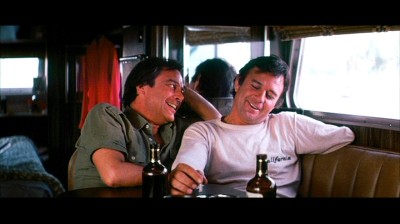
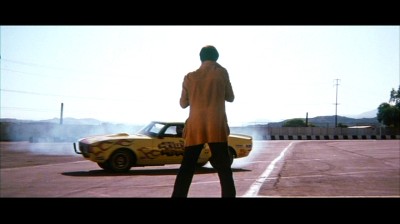
I haven't seen Double Exposure since I caught it on a crappy pan-and-scan VHS tape back in the mid-80s, but it always stayed in my mind because it seemed miles above most of the "slasher" flicks that were flooding the market at that time. Sporting a better-than-normal cast, and shot in glossier-than-expected widescreen style, Double Exposure holds up surprisingly well today, considering its low-budget limitations. Even with two commentary tracks on this disc (including one with star Michael Callan), I wasn't quite clear on the exact connection between this effort and Callan's and director Hillman's earlier slasher effort, 1974's The Photographer. From what I could gather from the tracks, writer/director/producer Hillman came to Callan with the intent of updating The Photographer, incorporating the murder scenes footage from that story of a photographer who killed his models, into a new movie, Double Exposure, where a photographer thinks he's killing his models. For unspecified legal reasons, this approach was abandoned, and the decision was made to tweak the first film's story for this "remake" (although there are conflicting stories on this origin, as well as uncertainty about if one particular scene from the earlier film still made it into the newer one). According to producer/star Callan, once the film was shot (with about a million dollar budget), Crown International Pictures was chosen to release it...and according to the star, they dropped the ball after a preview run went badly, dooming Double Exposure to "cult" status where it eventually gained a small-but-loyal following from its video and cable exposure.
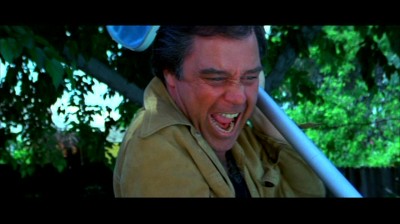
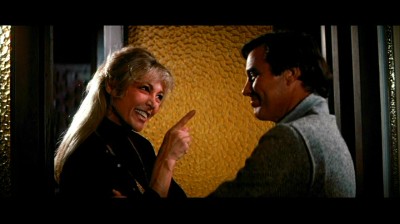
Double Exposure has a few weak points in its story construction, including the initial pick-up meeting between Pettet and Callan that plays unrealistically, and Callan's big "for your consideration, Oscar" scene where he's screaming back and forth into a mirror―a good scene, SPOILER but one that doesn't make much sense unless Callan is the killer, or he has a psychic connection to his brother that the film doesn't make clear enough (that symbiosis of dreams and killings between brothers makes sense...but the film doesn't make that connection well enough for the viewer). However, for most of its running time, Double Exposure is an unexpectedly effective psychological thriller/slasher film. Writer/director Hillman apparently let the actors improvise a little bit, and the results are a series of slightly "off," vaguely uncomfortable, tense scenes of interaction between characters who are constantly on edge, constantly anxious, terrified of their own psyches, or of what they're capable of, or of what will become of them. Double Exposure has a heavy edge to its vibe that comes from these believably open-ended dialogue scenes that you just don't see (or feel) in the typical 80s cheapo slasher flicks (any time Stacy and Callan are together on screen, the viewer has no idea what's going to happen next). Hillman allows plenty of time for the characters to develop, giving them scenes that wouldn't even have been shot in other slasher films at the time (like Stacy trying to pick up the girl in the bar...and failing, or the car racing scene, where we see both Stacy's and Callan's "death wishes"). And those shadings of character development only help Double Exposure when it's time to get down to the business of killing models.
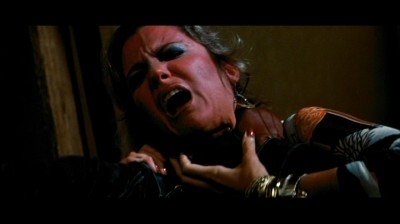
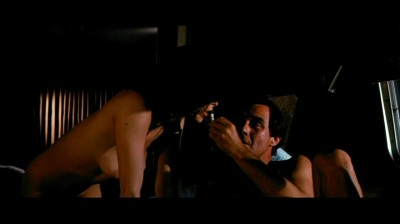
In his commentary track, Callan didn't seem too willing to call Double Exposure a "slasher film" (although cinematographer R. Michael Stringer has no problem labeling it as such), but identifying those subgenre elements doesn't diminish or take away from the many potent straight dramatic scenes, or the overall somber, tense tone that successfully permeates the movie. Director Hillman and cinematographer Stringer know how to move the camera in a smooth, silky (and threatening) manner, while the murder scenes―let's face it: the elements that most likely grabbed the audience―are staged with an unsettling, even sick, force. When Hillman has Callan "kill" a model in a pool with a skimmer pole, he keeps cutting back to Callan's disturbing face, set in a grotesque soundless scream. Sally Kirkland, showing off an amazing body, believably takes a few moments to finally realize she's being strangled before panic sets in and the killer snaps her neck. Toni's death by a rattler in a bag over her head is perhaps the movie's most gruesome killing (made even more so because we don't actually see anything―we imagine the indescribable horror going on in that black trash bag), while April getting split open by Callan is technically quite impressive...and horrifying. And while we're at it, since this element was as critical to an 80s slasher films as gore was―the nudity is top-notch, including the aforementioned Kirkland, a beautiful actress named Teressa Macky who plays the horny, unlucky April, and gorgeous Joanna Pettet, one of the hottest actresses of the 60s, looking terrific here twenty years later.
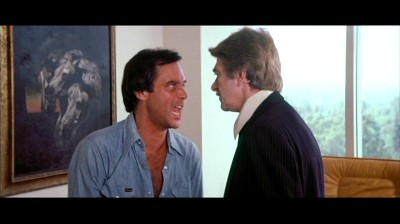
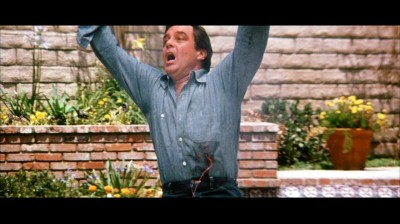
Of special note for Double Exposure are the exceptional cinematography and music, too. Cinematographer R. Michael Stringer may complain in his track about having to use anamorphic lenses here, but the rich, deep, glossy, widescreen look of Double Exposure puts it way ahead of most of the early 80s cheapjack slasher flicks. As well, the score by Jack Goga has a scary sweep to it that, when matched with the A-list cinematography, gives Double Exposure a visual/aural heft that puts it in the ranks with comparable front tier studio releases (in addition to the P.O.V. shots of the killer stalking his victims, with Goga's "ocean-in-a-subway" track heightening the suspense, there's a remarkable, dizzying helicopter shot of Callan's huge, white RV moving through traffic as Goga's epic music pounds on the soundtrack―you just don't see production values like that on most of these slasher flicks). The main leads are uniformly fine, with Pettet sympathetic and lovely, sweaty, unwell-looking Callan realistically harried and losing control, and Stacy reaching some uncomfortable depths as the movie refuses to shy away from exploiting his handicap. A memorable, disturbing little psychological suspenser.
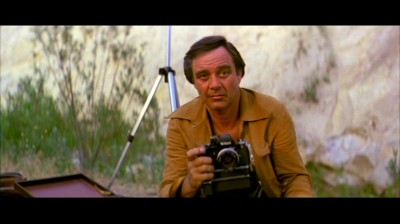
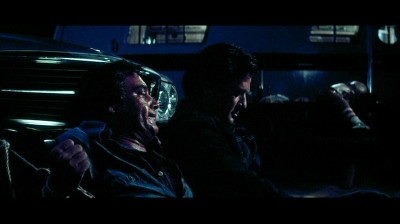
The DVD:
The Video:
Scorpion advertises this transfer as a "brand new 16x9 (2.35:1) HD master from the original internegative, first time anywhere in its original scope ratio." It looks terrific: blacks are deep and stable, colors are correctly valued, and the image is super-sharp (with just a bit of grain, as expected). Edge enhancement is acceptable.
The Audio:
The English mono audio track is re-recorded at a pleasingly hefty level. Hiss is barely present, and all dialogue is crisp. No subtitles or closed-captions are available, though.
The Extras:
You can choose to watch Double Exposure in Scorpion's Katarina's Nightmare Theater format...which just means you get the opening and closing bumpers that Scorpion's Katarina Leigh Waters cuts for these disc releases (...you can skip them). Next up is Waters' on-camera interview with star Michael Callan (he looks great), discussing his career and this production; it runs a quick 10:37. Waters also plays moderator for the two commentary tracks included here, first with star Michael Callan and Hostel producer Scott Spiegel, and second with cinematographer R. Michael Stringer and his wife, script supervisor Sally Stringer. The Stringer commentary has lots of good inside dope on how the movie was actually was shot (even if the Stringers don't sound exactly excited about this particular movie). As for Waters moderating, there's an unintentionally funny moment where she can't find her notes...before she asks about Seymour Cassel working with "John Cassavelle."
Callan's track might have been more fun...if I didn't have to hear that constant inane fan-boy giggling and all the high-brow "Oh, wow!"s and "Holy sh*t!"s and "F*cking crazy!"s of Spiegel's that added so much depth to the discussion (seriously, I don't know if Tarantino stole Spiegel's act, or vice versa, but it is played, okay?). Funniest moments on the track? Either Spiegel mixing up Callan's The Victors with Liz and Dick's The V.I.P.s, or his trying to "connect" with Callan's experiences of working with top-flight Hollywood stars like Alan Ladd...by stating he worked with Alan Ladd's granddaughter (you can hear the crickets from Callan's corner when that one goes out). Callan, increasingly terse through all of this as the track goes along, sums it up best to Spiegel: "You talk too much." An original trailer for the movie is included, as well.
Final Thoughts:
A snazzy little psychological suspenser/slasher flick. Apparently, Crown International Pictures just dumped Double Exposure after a bad preview run in 1982, so not too many people or critics saw it when it came out in January, 1983―and that's too bad because it's one of the best entries in that much-maligned subgenre. A better-than-average cast, a tense, well-developed script, some superior direction, scoring and lighting, and well-done gore and nudity. Worth seeking out not only for slasher flick fans, but anyone who enjoys a dark, psychological thriller. I'm highly recommending Double Exposure.
Paul Mavis is an internationally published film and television historian, a member of the Online Film Critics Society, and the author of The Espionage Filmography.


|
| Popular Reviews |
| Sponsored Links |
|
|
| Sponsored Links |
|
|
| Release List | Reviews | Shop | Newsletter | Forum | DVD Giveaways | Blu-Ray | Advertise |
|
Copyright 2024 DVDTalk.com All Rights Reserved. Legal Info, Privacy Policy, Terms of Use,
Manage Preferences,
Your Privacy Choices | |||||||









